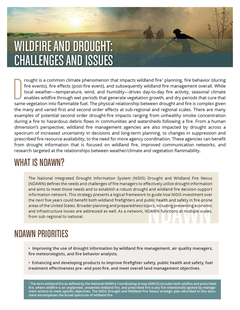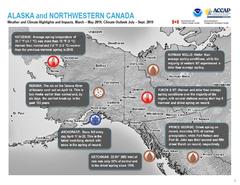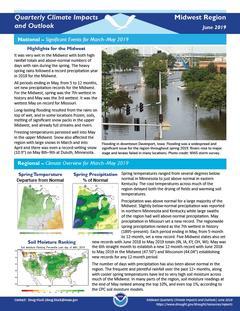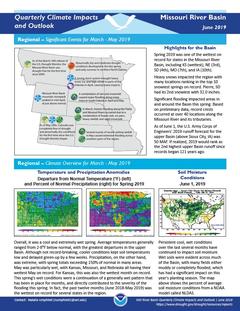Drought is a common climate phenomenon that impacts wildland fire1 planning, fire behavior (during fire events), fire effects (post-fire event), and subsequently wildland fire management overall. While local weather—temperature, wind, and humidity—drives day-to-day fire activity, seasonal climate enables wildfire through wet periods that generate vegetation growth, and dry periods that cure that same vegetation into flammable fuel.
Quarterly Climate Impacts and Outlook for Alaska and Northwestern Canada for March – May 2019; outlook for July – September 2019. Dated June 2019.
Most of Alaska, Yukon, the western portion of the Northwest Territories (NT) and northern British Columbia (BC) were significantly warmer than normal during this past spring, with some areas in Yukon, and the NT near record warmth. In contrast, a small area in northwestern BC was colder than normal. Temperatures over the remainder of BC averaged near normal.
Quarterly Climate Impacts and Outlook for the Great Lakes Region for March – May 2019. Dated June 2019.
Across much of the basin, spring averaged out to be colder than normal, with temperatures as much as 3°C (5°F) below normal while the far southeastern areas were near normal for the spring. Spring precipitation ranged from 101% to 118% of average.
Quarterly Climate Impacts and Outlook for the Southern Region for March – May 2019. Dated June 2019.
Spring temperatures exhibited a west-to-east pattern across the region in general, with above normal temperatures in the east and normal to slightly below normal temperatures in the western states. Spring precipitation was primarily above normal across the Southern Region.
Quarterly Climate Impacts and Outlook for the Midwest Region for March – May 2019. Dated June 2019.
Spring temperatures ranged from several degrees below normal in Minnesota to just above normal in eastern Kentucky. Precipitation was above normal for a large majority of the Midwest.
Quarterly Climate Impacts and Outlook for the Western Region for March – May 2019. Dated June 2019.
Spring temperatures were variable across the West. The North Pacific storm track remained active through the spring season bringing above normal precipitation to much of the West.
Quarterly Climate Impacts and Outlook for the Missouri River Basin March – May 2019. Dated June 2019.
Average temperatures generally ranged from 2-8°F below normal, with the greatest departures in the upper Basin. Precipitation, on the other hand, was extreme, with spring totals exceeding 150% of normal in many areas.
Quarterly Climate Impacts and Outlook for the Southeast Region for March – May 2019. Dated June 2019.
Above-average temperatures were recorded over most of the Southeast. Mean temperatures were 2-4 F above normal for most of the region. Spring precipitation was around 50% to 90% of normal across much of the Southeast, except in western NC, and parts of central NC and AL, where it went up to 130% of normal.
Quarterly Climate Impacts and Outlook for the Chesapeake Bay Region for March – May 2019. Dated June 2019.
Spring temperature was above average for most of the Chesapeake Bay watershed. Spring precipitation was up to double historical averages in the northern Chesapeake Bay.
Quarterly Climate Impacts and Outlook for the Northeast Region for March – May 2019. Dated June 2019.
The Northeast's spring average temperature was near normal, ranking in the middle third of all years. The Northeast received 112% of normal precipitation during spring, ranking in the wettest third of all years.











